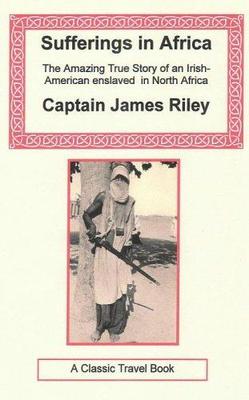Sufferings in Africa facts for kids
 |
|
| Author | James Riley |
|---|---|
| Original title | Authentic Narrative of the Loss of the American Brig Commerce |
| Country | England |
| Language | English |
| Genre | Memoir, Christian slave narrative |
|
Publication date
|
1817 |
| Media type | Print (hardcover, paperback), audio cassette |
| ISBN | 1-59048-108-9 |
Sufferings in Africa is a true story written in 1817 by James Riley. It's a memoir, which means it's a story based on his own memories and experiences. The book tells the amazing and difficult journey of Captain Riley and his crew.
In 1815, their ship, the Commerce, was wrecked off the coast of Western Sahara. Captain Riley then had to lead his crew through the huge Sahara Desert. The book was first called Authentic Narrative of the Loss of the American Brig Commerce. Today, it's known as Sufferings in Africa.
This book describes how they became shipwrecked. It also shares their many challenges while trying to survive in the Sahara Desert. Captain Riley felt responsible for his crew's safety in this unknown land. He wrote about how they were captured by local people. These groups forced Riley and his crew to work for them. The men were treated very badly, often hungry and thirsty.
Contents
The Shipwreck and Desert Journey
After their ship was damaged, Riley and his crew tried to fix their small boat. They wanted to return to the ship instead of facing the desert. But before they could finish, a local person with a spear arrived. This person took some of their limited supplies.
Soon, two more people with spears joined him. Captain Riley stayed behind to distract them. This gave his men a chance to escape in the boat. They got away, but Riley was left behind. He offered his captors money for his freedom.
One crew member, Antonio Michele, swam back to shore to pay them. At that moment, Riley ran into the water to join his men. Their ship was still stuck and couldn't be used. They decided to sail south, hoping for rescue.
After nine days, they ran out of food and water. They returned to an isolated beach about 200 miles south. They knew they were in great danger. The shore was surrounded by high cliffs. Riley told his men to start digging for water.
He climbed to the top of the cliffs. From there, he saw a huge, flat desert stretching out before them. His crew joined him, and they began walking inland. They hoped to find a friendly tribe.
But soon, they lost hope. The desert was extremely hot during the day, reaching 120 degrees Fahrenheit. At night, it became freezing cold. With no food or water, Riley decided they had two choices. They could either accept death or offer themselves to the first tribe they met. This is exactly what happened.
Life as Captives and Hope for Freedom
A large group of men and camels appeared in the distance. Riley and his crew approached them. The tribe then began to argue among themselves. They were deciding who would take the shipwrecked men. Riley's crew members were separated. Different groups took them, and then went their own ways.
Riley wrote in his memoir about the very difficult days he spent as a captive. After some time, he learned a little of the local language. This helped him communicate in a basic way. One day, some Arabs arrived to trade with his captor.
Riley asked two of them, Sidi Hamet and his brother, if they would buy him and his shipmates. He asked them to take them to the closest city, Mogador (now Essaouira). This city was hundreds of miles to the north. Hamet was touched by Riley's strong wish to save his friends.
Hamet agreed to buy them. Riley promised to pay him with cash and a gun when they reached the city. This was a complete lie, as Riley knew no one there. When it was time for Riley to write a note asking for help, he was very scared. He had to write to a complete stranger, begging for a lot of money. He had no other choice. In the note, he explained who he was and his situation.
Traveling through the desert was hard for everyone, both the captors and the captives. There was little food for the already starving American men. There was also little water for anyone. It was amazing that they traveled hundreds of miles to the city. They were constantly afraid of other groups of people in the desert. They were especially worried about one of the brothers' father-in-law, who wanted to settle an old disagreement.
Reaching Safety and Going Home
Eventually, they arrived at the edge of the city. Hamet took the note, which was for the town's consul, into town. A consul is like a representative from another country. Hamet met a young man in the city. This man worked for a British merchant named William Willshire. Willshire also acted as a kind of consul.
Hamet told Willshire about his "friend" and gave him the note. Willshire was impressed by the honesty of the note. He agreed to pay the money. Willshire rode out with a group to meet the men waiting outside the city. He greeted Riley with hugs and tears.
Riley sent his remaining men home to America. He stayed behind for a few days. Sidi Hamet, his former captor, promised to go back into the desert. He wanted to look for Riley's missing crew members. Riley returned to America and was reunited with his wife and five children in Connecticut.
Two of the missing men were later found and returned to the United States. Riley heard that two Arabs were killed in the desert by other groups. He believed they were his former captor and his brother, trying to keep their promise.
Images for kids


